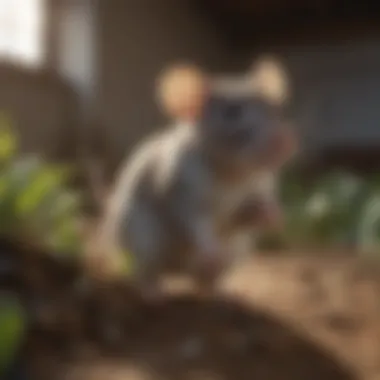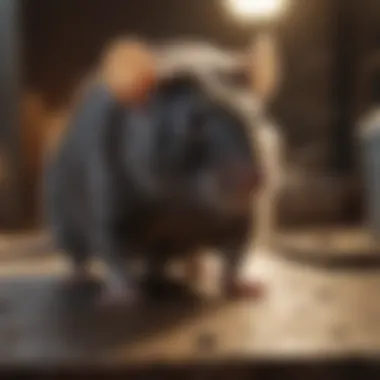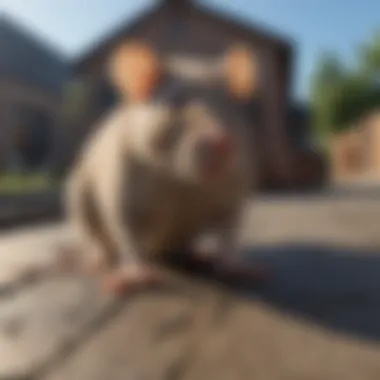Effective Strategies for Rat Removal From Your Roof - A Comprehensive Guide


Preventive Pest Control Strategies
When it comes to effectively managing a rat infestation in your roof, starting with preventive pest control strategies is crucial. To safeguard your home and ensure a pest-free living environment, several key measures must be taken.
House Exterior Protection
When dealing with rat infestations, it's essential to focus on the external areas of your house. Begin by sealing cracks in the exterior walls, foundation, and roof to prevent rodents from finding their way in. Additionally, clearing debris such as overgrown vegetation and woodpiles around your home can eliminate potential hiding spots for pests. By taking these steps, you can effectively deter rats from entering your home.
Yard Maintenance
Maintaining your yard is another critical aspect of rat control. Establish essential yard care routines, including mowing the lawn regularly and trimming shrubs to reduce potential nesting sites for rodents. Implement methods for keeping your yard pest-free, such as removing standing water sources that attract pests like rats.
Indoor Cleanliness
Indoor hygiene plays a significant role in pest prevention. Adopt expert cleaning tips and techniques to keep your indoor environment free from attractants that might draw rats inside. By maintaining a pest-resistant indoor space through regular cleaning and proper storage practices, you can create a less appealing environment for rodents.
Garbage Disposal
Proper garbage disposal methods are key to deterring rats. Ensure efficient waste disposal by using tightly sealed bins and disposing of trash regularly. By emphasizing the importance of proper garbage disposal, you can limit food sources that attract rats to your property.
Other Pest Prevention Strategies
In addition to these fundamental measures, exploring innovative ways to safeguard your home from pests is essential. By implementing a combination of preventive pest control strategies tailored to your specific property and surroundings, you can effectively combat rat infestations and maintain a pest-free environment.
Stay tuned for the next section on 'Identifying Pest Risk Areas' to dive deeper into rat control strategies!
Understanding Rat Infestations
Rat infestations in your roof can be a serious issue, impacting both the structural integrity of your home and the health of its occupants. Understanding the signs and risks associated with rat infestations is crucial for effective eradication. By identifying key indicators of rat presence early, you can intervene promptly and prevent the situation from escalating further. This section delves into the nuances of rat infestations, providing essential insights for homeowners seeking to safeguard their living spaces.
Identifying Signs of Rat Infestation
Droppings
Droppings are a common telltale sign of rat activity within a property. These fecal pellets are usually small, dark, and spindle-shaped, indicative of a rat infestation. The presence of droppings in specific areas signifies the rats' pathways, feeding locations, and nesting sites. While unsightly and unhygienic, droppings serve as critical evidence of a rat infestation, prompting homeowners to take immediate action. Regularly checking for and properly disposing of droppings are vital steps in controlling rat populations in the roof.
Gnaw Marks


Gnaw marks on wires, insulation, and structural components indicate the destructive nature of rats. These rodents have strong teeth that continuously grow, leading them to gnaw on various materials to wear down their teeth. Gnaw marks not only compromise the integrity of your home but also pose fire hazards due to exposed wiring. By recognizing and addressing gnaw marks promptly, homeowners can mitigate potential damage and enhance safety within their properties.
Scratching Noises
Audible scratching noises emanating from the ceiling often indicate rat infestations in the roof. Rats are nocturnal creatures that move around and forage during the night, producing distinct scratching sounds as they scurry about. Ignoring these noises can result in a worsening infestation, as rats breed rapidly and establish large colonies within confined spaces. Being attentive to scratching sounds enables homeowners to intervene early, preventing extensive damage to their property while safeguarding against the health risks associated with rat presence.
Preventative Measures
Preventative measures play a crucial role in the comprehensive guide on effectively eliminating rats from your roof. By implementing proactive strategies, homeowners can prevent rat infestations before they occur, saving time, money, and potential damage to their property. Emphasizing preventative measures sets the foundation for creating a pest-free living environment and avoiding the health risks associated with rats.
Sealing Entry Points
Gaps around pipes
Gaps around pipes are an essential focus when addressing rodent infestations in the roof. These openings provide easy access for rats to enter your home, leading to potential havoc. By sealing off these gaps, homeowners can effectively block rodents from moving in and causing destruction. The key characteristic of gaps around pipes is their sneaky nature—often overlooked but serving as primary entry points for rodents. Including strategies to seal these gaps in the overall pest control plan is crucial for long-term success. While sealing gaps around pipes prevents rat entry, it requires meticulous attention to detail to ensure all openings are properly secured.
Vents and chimneys
Vents and chimneys pose another common entry point for rats looking to nest in your roof. These openings, if left unsealed, can serve as welcome mats for unwanted pests. By addressing the sealing of vents and chimneys, homeowners can fortify their property against potential rat intrusions. The key characteristic of sealing vents and chimneys lies in its effectiveness in closing off access points that rats typically exploit. While this proactive measure provides a solid defense against infestations, it is essential to regularly inspect and maintain these sealed areas to prevent any breaches.
Roof gaps
Roof gaps represent a significant vulnerability in the defense against rat infestations. These overlooked spaces offer rats a direct path into your roof, where they can wreak havoc unnoticed. By addressing and reinforcing these roof gaps, homeowners can significantly reduce the risk of rodent intrusions. The key characteristic of focusing on roof gaps stems from their role as ideal hiding spots for rats seeking shelter. Properly addressing roof gaps in the context of pest control ensures a comprehensive approach to keeping your home rodent-free. While closing off roof gaps is essential, homeowners must also consider ventilation needs to maintain a healthy indoor environment.
Maintaining Cleanliness
Proper waste disposal
Proper waste disposal is a fundamental aspect of rat control in the roof. By disposing of waste promptly and correctly, homeowners can eliminate attractants that lure rats into their dwellings. The key characteristic of proper waste disposal is its ability to remove potential food sources for rats, thus reducing the likelihood of infestations. While emphasizing proper waste disposal in rat prevention efforts, homeowners must also consider securing trash cans and bins to prevent easy access for rodents.
Regular cleaning
Regular cleaning plays a vital role in maintaining a rat-free environment. By keeping living spaces tidy and clutter-free, homeowners can eliminate hiding spots for rats and deter them from establishing nests. The key characteristic of regular cleaning is its ability to disrupt the comfort zones of rodents, making the environment less hospitable for infestations. While regular cleaning is effective in reducing rat populations, homeowners should pay particular attention to areas that are prone to dirt buildup and clutter.
Securing food sources
Securing food sources is paramount in rat control efforts. By storing food properly and eliminating crumbs or spills, homeowners can remove incentives for rats to stay in their homes. The key characteristic of securing food sources lies in its role as a preventative measure, cutting off the food supply that sustains rat populations. While securing food sources is crucial, homeowners should also address other potential attractants, such as pet food left out overnight and easily accessible water sources.


Trapping and Removing Rats
In this article, the topic of Trapping and Removing Rats holds paramount importance as it directly addresses the core issue of eliminating rats from the roof effectively and efficiently. It plays a crucial role in ensuring a pest-free environment and safeguarding the home from potential damage and health risks associated with rat infestations. By focusing on trapping and removing rats, individuals can take proactive steps to address the root cause of the infestation, preventing further proliferation and ensuring long-term relief.
Choosing Appropriate Traps
Snap traps:
Snap traps offer a specific approach to rat control by swiftly trapping and eliminating rodents upon activation. Their key characteristic lies in their mechanical design, which ensures a quick and humane kill. Snap traps are a popular choice for this article due to their reliability and effectiveness in capturing rats. The unique feature of snap traps is their sensitivity, triggering instant response upon rat contact. While snap traps are efficient in rat removal, they may require frequent resetting and pose safety concerns if not handled properly.
Live traps:
Contrary to snap traps, live traps focus on capturing rats alive for later release in a suitable location. Their key characteristic is the ability to trap rats without causing harm, offering a more humane approach to rodent control. Live traps are a beneficial choice for this article as they provide a non-lethal method of removing rats. The unique feature of live traps is their versatility in capturing multiple rats at once. However, live traps require regular checks to ensure timely relocation of captured rats and may not be as swift in controlling large infestations.
Glue traps:
Glue traps present a different mechanism for trapping rats by adhering them to a sticky surface upon contact. Their key characteristic is the simplicity of use and disposal, making them a convenient option for rat control. Glue traps are favored in this article for their ease of deployment and cost-effectiveness. The unique feature of glue traps is their ability to trap rats without relying on bait, attracting rodents solely through the adhesive surface. While glue traps are effective in catching rats, they raise ethical concerns regarding the prolonged suffering of trapped rodents and may not be suitable for use in environments with pets or other animals.
Professional Extermination Services
In the realm of effectively eradicating rats from your roof, professional extermination services play a pivotal role. These services bring a level of expertise and efficiency that is often crucial in dealing with persistent rat infestations. Professional exterminators are equipped with the knowledge, tools, and experience necessary to tackle even the most challenging rat problems. Engaging professionals can save you time and effort while ensuring a thorough and effective removal process. Their specialized skills can help identify entry points, nesting areas, and the extent of the infestation, allowing for targeted elimination strategies.
When to Seek Professional Help
Extensive infestations
When faced with extensive rat infestations, reaching out to professional exterminators becomes essential. Extensive infestations refer to situations where a large number of rats have infiltrated your property, making DIY solutions less feasible. Professional help is beneficial in such cases as experts can efficiently assess the scope of the infestation, formulate a customized eradication plan, and implement it with precision. Their expertise in handling severe rat problems reduces the risks of incomplete extermination and ensures a comprehensive solution.
Persistent issues
Persistent rat issues denote recurring infestations that are challenging to eradicate permanently. Seeking professional assistance for these ongoing problems is wise as experts can identify underlying causes leading to repeated infestations. Additionally, they can implement targeted interventions to disrupt the rat population's cycle and prevent future recurrences. Professional exterminators offer long-term solutions that address the root of the problem, safeguarding your home against persistent rat invasions.
Risk factors
Identifying and mitigating risk factors associated with rat infestations is crucial for maintaining a safe and healthy environment. Professional exterminators excel in assessing these risks and implementing proactive measures to minimize them. By availing of professional services, you benefit from their ability to navigate potential hazards effectively. Moreover, the expertise of professional exterminators ensures that all extermination activities are conducted safely, reducing the risks posed by handling potentially harmful chemicals or materials. Overall, professional extermination services play a vital role in minimizing the health and safety risks associated with rat infestations.
Choosing a Reliable Extermination Service


Credentials and reviews
When selecting an extermination service, evaluating credentials and reviews is paramount. Credentials validate the expertise and qualifications of the extermination team, ensuring that you are entrusting your rat problem to capable professionals. Reviews from previous customers offer valuable insights into the service quality, reliability, and customer satisfaction levels. By considering both credentials and reviews, you can make an informed decision and choose an extermination service that meets your specific needs.
Methods used
Understanding the methods employed by an extermination service is essential in determining their suitability for your rat infestation. Different exterminators may utilize varied approaches, such as trapping, baiting, or sealing entry points. Evaluating these methods allows you to gauge their effectiveness, safety, and environmental impact. Opting for an extermination service that aligns with your preferences and concerns ensures a satisfactory eradication process that meets your expectations and ensures rat-free surroundings.
Warranty and follow-up
A reliable extermination service should offer warranties and follow-up services to guarantee the effectiveness of their treatments. Warranties provide assurance that if rat activity persists post-extermination, the service will address the issue at no extra cost. Follow-up visits enable exterminators to monitor the situation, make necessary adjustments, and ensure long-term eradication success. Choosing a service that offers comprehensive warranties and proactive follow-up demonstrates their commitment to customer satisfaction and rat-free environments.
Maintaining a Rat-Free Environment
Maintaining a rat-free environment is crucial in ensuring a healthy and safe living space for you and your family. By implementing consistent measures to keep rats at bay, you can prevent costly damages and health risks associated with rat infestations. This section focuses on specific elements, benefits, and considerations related to maintaining a rat-free environment.
Regular Inspections and Maintenance
Checking for Entry Points
Checking for entry points is a fundamental aspect of rat control as it helps identify how these pests are gaining access to your home. This proactive approach allows you to block potential entryways, such as gaps in walls, vents, or pipes, effectively keeping rats out. Regular inspections for entry points are beneficial for early detection of rat presence and for preventing future infestations.
Monitoring Activity
Monitoring rat activity involves observing signs of infestation, such as droppings, gnaw marks, and noises. By actively monitoring these indicators, you can track the extent of the infestation and take appropriate action to eliminate rats from your property. Continuous monitoring helps in assessing the effectiveness of pest control methods and identifying areas that require further attention.
Repairing Damages
Repairing damages caused by rats is essential for maintaining a rat-free environment. Rats can cause structural harm by gnawing on wires, insulation, and wood, compromising the integrity of your home. Timely repairs not only prevent further damage but also deter rats from re-entering the premises. By addressing and fixing rat-induced damages promptly, you can safeguard your property and avoid future infestations.
Sustainable Practices
Natural Deterrents
Incorporating natural deterrents, such as peppermint oil or predator urine, can help repel rats from your home without harsh chemicals. These non-toxic solutions offer an eco-friendly approach to pest control, minimizing risks to the environment and your family. Natural deterrents provide a safe and sustainable method for deterring rats while maintaining a healthy living environment.
Environmentally Friendly Solutions
Opting for environmentally friendly solutions, like ultrasonic repellents or biopesticides, offers effective rat control without harming the ecosystem. These eco-conscious alternatives target rats specifically, reducing the need for broad-spectrum chemicals that may have adverse effects on non-target organisms. Environmentally friendly solutions prioritize sustainability while effectively managing rat infestations.
Long-Term Prevention
Implementing long-term prevention strategies, such as sealing entry points and regular maintenance, is key to sustaining a rat-free environment. By focusing on proactive measures and sustainable practices, you can prevent recurrent rat infestations and maintain a pest-free home for the long term. Long-term prevention strategies prioritize durability and effectiveness, ensuring lasting protection against rats in your roof.



